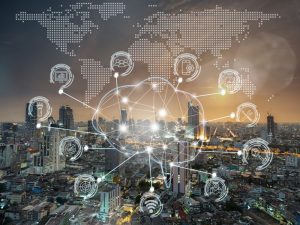 What’s that buzz on the power line? It’s AI, of course! But what is AIoT, you ask? It is applying artificial intelligence (AI) to data from smart devices connected by the Internet of Things (IoT).
What’s that buzz on the power line? It’s AI, of course! But what is AIoT, you ask? It is applying artificial intelligence (AI) to data from smart devices connected by the Internet of Things (IoT).
AI is the science of training systems to perform human tasks through learning and automation. With AI, machines can:
- Learn from experience.
- Adjust to new inputs.
From back office operations to drone-based line inspections, there are tremendous efficiencies the utilities industry can gain through automation with the assistance of intelligence algorithms on IoT data. But we need to sort through the hype to better understand the practical applications for utilities.
I’ve been speaking with customers and reading analyst reports to better understand the reality of AIoT in utilities. In the process, I’ve uncovered five distinct areas where AIoT can have a measurable impact on improved efficiencies and business objectives. Here they are, in no particular order:

- Grid reliability. In the power grid itself, utilities can apply AI to the data from IoT devices in order to monitor and anticipate events that affect grid reliability. Utilities use troves of static data from smart line sensors and images collected from drones to build analytical models that can be deployed on data in motion or at rest. Artificial intelligence can anticipate grid disturbance and automatically issue a mitigating control to reduce or avoid an outage.
- Energy forecasting. Machine learning algorithms can predict energy demand and supply, then help optimize the dispatch and trading decisions within cost and emissions targets. Data used for energy forecasting is more dynamic than ever before, thanks to the IoT, from weather to real-time load. An adaptive machine learning algorithm may reduce forecast error and improve efficiency when the inputs are highly variable.
Create and sustain true value from diverse IoT data and initiatives with AI and analytics. Download the AIoT White Paper.
- Generation yield optimization. Energy production depends on the availability of generation assets. Utilities can use machine learning to optimize the startup / shut down process of rotating equipment, predict future maintenance needs based on performance degradations, and prevent unplanned downtime. McKinsey Global Insights writes, "machine learning can help optimize wind turbines’ yield based on their own past performance, real-time communication with other wind farms, the grid status, and changes in wind speed and direction."
- Microgrid management. The integration of Distributed Energy Resources (DERs), including microgrids, is a significant opportunity for the deployment of machine learning algorithms. AI can optimize IoT devices and orchestrate complex connections, but it must first be proven. If successful, AI/ML can improve the integration of renewable energy resources and reduce the losses that are experienced in energy grid today.
- Back office efficiencies. Utilities have significant back office processing, including new account setup and payment arrangements, fraud detection and claims processing. With natural language processing (NLP), a component of AI, many of these processes can be more efficient. For example, some utilities use virtual agents in call centers to listen to a caller’s purpose and automatically route them to the appropriate agent or online resolution based on service history. Utilities also rely on NLP to automatically classify property claims filed after major outage event. Machine learning algorithms improve models that predict non-technical loss and potential bad debt. Similar to opportunities to enhance general fraud detection through the application of AI, procurement integrity can be boosted with neural network techniques.
I believe that where AI and IoT meet is the next wave of innovation for utilities. As we look ahead to the digital utility of the future, it's apparent that decisions will be driven by better use of data and analytics in all forms, including AI.
Read the results of a survey by SAS and Zpryme: The Autonomous Grid in the Age of the Artificial Intelligence of Things.
